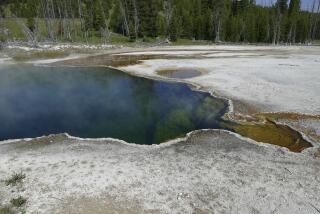U.S. Buffaloed by Bison Dilemma
- Share via
WASHINGTON — The National Park Service calls it “Natural Regulation”: If you leave Yellowstone Park’s buffalo alone, they will reproduce to the carrying capacity of the land, and no more. Nature will reduce the numbers.
Nature is doing its best this year. Heavy snow and thick sheets of ice have caused unprecedented numbers of buffalo to wander off to greener pastures--nay, any pastures--outside the park.
There, nature gets an assist from the Park Service and the state of Montana, whose agents are waiting with rifles. Nearly 1,000 buffalo have been shot or “removed” to slaughter this year.
Nobody likes this. It seems barbaric and perhaps cruel; it is unsightly; it is absolutely terrible PR. “Everyone likes animals,” said Andrew Malcolm, spokesman for Montana Gov. Marc Racicot. “They’re on our nickels too.”
But three competing bureaucracies are slugging it out here, with a heavy barrage of letters, communiques, news releases and finger-pointing. There is, however, no relief as yet for the buffalo.
Everybody’s got an investment to protect. The Agriculture Department’s Animal and Plant Health Inspection Service (APHIS) is embarked on a crusade against brucellosis, a disease that causes cows to abort their fetuses, and has spent $3.5 billion since 1935 to eradicate the disease.
Brucellosis is gone from Montana’s cattle, but buffalo also can carry it, and APHIS contends that 20% to 50% of the Yellowstone herd is infected. So whenever buffalo start wandering, Montana risks the possibility that APHIS will withdraw its brucellosis-free status.
This means nobody will buy Montana cattle, and since Montanans spent $36 million to get rid of the disease in the first place, they are willing to protect their investment with rifles.
There is no effective vaccine as yet, so APHIS’ solution to brucellosis is to kill an entire herd when an animal has it. This “is not a possibility” in Yellowstone, says APHIS spokesman Patrick Collins.
He’s right. When the Yellowstone buffalo became the first protected species in America in 1902, there were 23 of them, and the Park Service spent the next 60 years bringing them back from extinction.
Today, there are hundreds of thousands of commercially grown buffalo in the country, but the Yellowstoners are the country’s only free-roaming herd. Getting rid of a national symbol is not an option.
“Natural regulation” began in the 1960s, and essentially means letting what’s going to happen, happen, according to Park Service wildlife biologist Wayne Brewster. Ordinarily, he said, about 200 animals get shot each winter for daring to leave the park.
But this year, double snowfall was followed by rain, followed by below-zero temperatures. So unprecedented numbers of buffalo decided to take their chances elsewhere. At the beginning of the year, the park had between 3,200 and 3,500 buffalo, Brewster said. By spring, “it would not be surprising to have between 1,200 and 1,000 or even less.” Which is major winterkill.
Brewster acknowledged that Montana, assisted by the Park Service, was “in fact” doing the culling that nature requires.
The methodology--a bullet to the brain--is the same as that used on a smaller scale in the past. Nonetheless, the New York-based Fund for Animals recently took out an ad in USA Today asking visitors to “Boycott Buffalo Butchery” by refusing to visit Montana.
Agencies are trying to agree on a plan. Options include:
* Putting buffalo temporarily in a national forest for the rest of the winter. (Montana hasn’t bought this yet, since cattle use the land in summer.)
* “Hazing” strays back into the park. (This has been tried on a small scale, with little success.)
* Or, finally, killing the brucellosis-positive migrants and sending the rest to Native American reservations to start new herds. This is politically and culturally correct, the tribes want them, and it makes sense.
The feds better grab it. They’ve already blown this one. Big time.
Guy Gugliotta is a national reporter for The Post.
More to Read
Sign up for Essential California
The most important California stories and recommendations in your inbox every morning.
You may occasionally receive promotional content from the Los Angeles Times.










